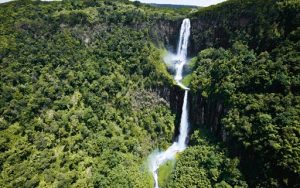
Scientist and environmentalist have locked horns with the government on the
destruction effect the road will have on the Abadare ecosystem, arguing that
environment effects outweigh all other economic benefits. Conservation Alliance of Kenya CAK has filed a new petition.
The proposed construction of a road cuts through the Abadare National Park to link Nyandarua and Nyeri County. Conservationists have condemned National
Environmental Management Authority NEMA’s action, saying the Agency tasked to protect the environment is putting a fragile ecosystem at risk. Nema had given the government a green light to proceed with the controversial project.
Proponents of this undertaking say the road has full socio economic benefits, they
argue that road would boost tourism and Agriculture. It will also cut the travel time by more than one hour and 30 minutes over the other available alternatives.
Environmental concerns
The road passes through a protected forest area. Conservationist and scientist have expressed fears that this will have an irreparable damage to the ecosystem. The Area comprises of 300 hectares of delicate ecosystems, including moorland, closed canopy forest, a wildlife habitat designated as a national park, wildlife corridors, wetlands, and other important conservation areas. This loss could disrupt wildlife migration leading to a decline in wildlife populations. The serene canopy and the majestic water tower water fall may become a distant memory as the highway cutting through the forest would disrupt all that.
Also there will be a reduction of water flow to the Sasumua and Ndakaini dams, Athi and Tana River, Ewaso Nyiro, Lorian Swamp, River Malewa, and Lake Naivasha. This would negatively impact key economic activities and livelihoods, causing losses in horticulture, hydro-electricity supply, agriculture together with ecotourism. Increased illegal activities such as wildlife poaching, logging, waste pollution, and wildlife roadkill during and after construction.
The project would attract human settlement and commercial development that would affect the communities and livelihoods using the Abadare as far as Nairobi. This means that destruction to this ecosystem will affect all of us.
The looming climate change is real and with us. lives and livelihoods have been
devastated. it is high time Human rights organization advanced the climate justice
construct in a manner that relates to the populace.
The Constitution of Kenya empowers persons to seek redress when their right to a healthy and clean environment has been violated or infringed. Article (69) (2) imposes obligations on every person, to cooperate with state organs and other persons to protect and conserve the environment and ensure ecologically sustainable development and use of natural resources. The ecological value of the area is bigger than the road.
Alternative way without pain
The economic and land tribunal is seeking to halt the construction of the highway.
Conservation Alliance of Kenya (CAK) wants the tribunal to compel the government to configure an alternative route. The Alliance cited severe environment impact the planned Highway will cause and sought cancellation of the NEMA license.
The conservationist has proposed an alternative route that they say balances both the environment and economic benefit of such a project. The proposed route cuts through small towns and villages. This will benefit the communities to transport their farm produce. Residents living along the proposed route say the road would greatly improve their livelihoods. This they argue is better than the one that passes inside the forest as it will bring conflict between human beings and the animals.
Conclusion
Abadare is one of those systems that is connected, building a road through it will
disconnect that ecosystem. It is a water catchment area for the Sasumua and Ndakaini dams, which provide most of the water to the Capital city. The better option is an alternative route that have better economic returns for these connections for the county of Nyeri, Nyandarua, Nakuru and Laikipia that would be economic viable and would also assist the community.
It is worth noting that while we are investing in road infrastructure we have to make sure that we are maximizing the socio-economic benefit while minimizing the negative impact in particular to the environment. We are responsible for a call to climate justice…lest we forget.
Author: James
James Adala is a researcher and a writer working as programs officer with Kituo
